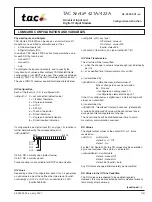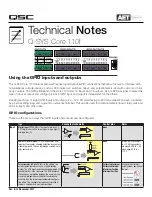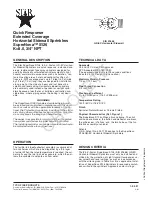
2(4)
02-00002-01-en, July 2007
SNVT vs TAC XENTA I/O MODULE COMMUNICATION
The TAC Xenta 421A/422A can be used in networks with
either L
ON
M
ARK
communication or TAC Xenta I/O module
communication. The device automatically determines which
type of communication to use.
Power-up
SNVT
TAC Xenta
I/O module
communication
Green
off-line
blink
Green blink
at comm.
or 0.1 Hz
I/O on-line:
green 0.5 Hz
SNVT
received
TAC Xenta I/O module
communication
established
TAC Xenta
I/O module
comm.
established
In the Power-up state, the green LED blinks "Off-line". The
device is open for
both SNVT and TAC Xenta I/O module
communication.
Previous configuration, if defined, will apply until a change is
initiated.
SNVT received
The device enters the SNVT state. The device is configured
when the
nci:s are updated. The green LED will light up when
there is communication or approximately every 10 seconds.
SNVT transmission is determined by the
nciSndDelta1-4 or
the
nciSndHrtBt values.
The device remains in the SNVT state until a TAC Xenta I/O
module communication state is established, or until the next
power-up. In the SNVT state it is possible to change the
configuration by updating the network configuration inputs
nci:s.
TAC Xenta I/O module Communication
The TAC Xenta I/O module communication state is accepted
only after a thorough protocol initiation. This may be initiated
at any time.
In the TAC Xenta I/O module communication state, no
nvi:s or
nci:s can be used. The green LED blinks on-line at about 0.5 Hz.
Input SNVTs are ignored, also when the device is off-line from
the controller.
Green LED (Communication)
- SNVT: at communication or ~ once in 10 sec.s
- TAC Xenta I/O mod communication:
on-line ~ every other sec; off-line ~ 5 blinks per sec
Red LED (Configuration error)
- blinking: unconfigured node
- steady: appl.less (or hw fault)
LED indicators on front panel
To determine if all
nviDO1-5 are to be considered valid, an
interval counter is used:
nciRcvHrtBt
No. of seconds until
nviDO1-5 are considered
invalid. (0: function is not used; default value.)
If this happens, due to communication failure, the behavior is
determined by
nciOfflineBeh, using the following bits:
DO 1
DO 2
DO 3
DO 4
DO 5
However, output SNVT transmission is still performed using a
hard-coded interval of about 10 seconds.
Once in the TAC Xenta I/O module communication state, the
device can only enter the SNVT state after a new Power-up.
At this stage all
nci:s must be updated, since the same
memory area is used by both the SNVT and TAC Xenta I/O
module communication configuration parameters.
Note!
As the TAC Xenta I/O module communication state is a
'dead-end' (until power-up), any mis-addressed communi-
cation may cause the I/O module to loose its SNVT communi-
cation state.
TAC Xenta I/O module communication is inititiated by the
controller at events specified below. If an I/O module intended
for SNVT communication has been used in another
configuration and happens to have an address that is used by
the I/O module communication, the I/O module will be 'lost' in
this state.
TAC Xenta I/O module communications will be initiated by the
following events:
•
Controller power-up
•
I/O module power-up
•
Controller application download
•
Recovery after communication failure
If bit=0: Keep latest value (default).
If bit=1: Use default value as specified by
nciOfflineVal, using the following bits, where the value to be
used is specified (0 or 1). (Default value=0.)
DO 1
DO 2
DO 3
DO 4
DO 5
Service pin
Bit 0
Bit 15
Bit 0
Bit 15
State diagram






















